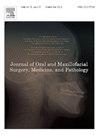Clinicopathological study on diameter of extranodal extension of cervical metastatic lymph nodes in the prognosis of oral cancer
IF 0.4
Q4 DENTISTRY, ORAL SURGERY & MEDICINE
Journal of Oral and Maxillofacial Surgery Medicine and Pathology
Pub Date : 2024-06-21
DOI:10.1016/j.ajoms.2024.06.008
引用次数: 0
Abstract
Objectives
To investigate the relationship between the degree of destruction of the cervical lymph node capsule, extranodal invasion distance, and the prognosis of extranodal extension (ENE)-positive patients
Study design
We retrospectively examined microscopic slides from neck dissection specimens of ENE-positive patients of our hospital. The ENE distance was measured by a pathologist who set up a virtual lymph node and measured the maximum extranodal invasion distance. The maximum distance was used for multiple ENEs. Forty patients with ENE were enrolled in this study. The Kaplan–Meier method was used to estimate survival.
Results
Among the ENE-positive cases, the capsule was completely destroyed and partially destroyed in seven and 33 cases, respectively. Disease-specific survival (DSS) was 1251 days (range 156–3009 days). The median distance of extranodal invasion was 2500 µm (392–8500 µm) in the 33 ENE-positive cases in which the capsule was not completely destroyed. Receiver operating characteristic curve analysis of these 33 cases showed that the cutoff value of extranodal invasion distance for progression-free survival was 2241 µm.
Conclusions
ENE is a prognostic predictor of oral cancer; ENE was an independent prognostic factor; and ENE size cutoff of 2241 µm was a significant prognostic factor.
口腔癌预后中宫颈转移淋巴结外延直径的临床病理学研究
目的研究颈淋巴结囊的破坏程度、结外侵犯距离与结外扩展(ENE)阳性患者预后之间的关系。ENE距离由病理学家测量,病理学家设置了一个虚拟淋巴结,并测量了最大的结外侵袭距离。多个ENE均以最大距离为准。本研究共纳入了 40 例 ENE 患者。结果在ENE阳性病例中,分别有7例和33例的囊完全破坏和部分破坏。疾病特异性生存期(DSS)为1251天(范围为156-3009天)。在 33 例ENE阳性病例中,囊膜未被完全破坏的结节外侵中位距离为 2500 µm(392-8500 µm)。对这33例病例进行的接收者操作特征曲线分析表明,无进展生存期的结节外侵犯距离临界值为2241微米。结论ENE是口腔癌的预后预测因子;ENE是一个独立的预后因子;ENE大小临界值2241微米是一个重要的预后因子。
本文章由计算机程序翻译,如有差异,请以英文原文为准。
求助全文
约1分钟内获得全文
求助全文
来源期刊

Journal of Oral and Maxillofacial Surgery Medicine and Pathology
DENTISTRY, ORAL SURGERY & MEDICINE-
CiteScore
0.80
自引率
0.00%
发文量
129
审稿时长
83 days
 求助内容:
求助内容: 应助结果提醒方式:
应助结果提醒方式:


